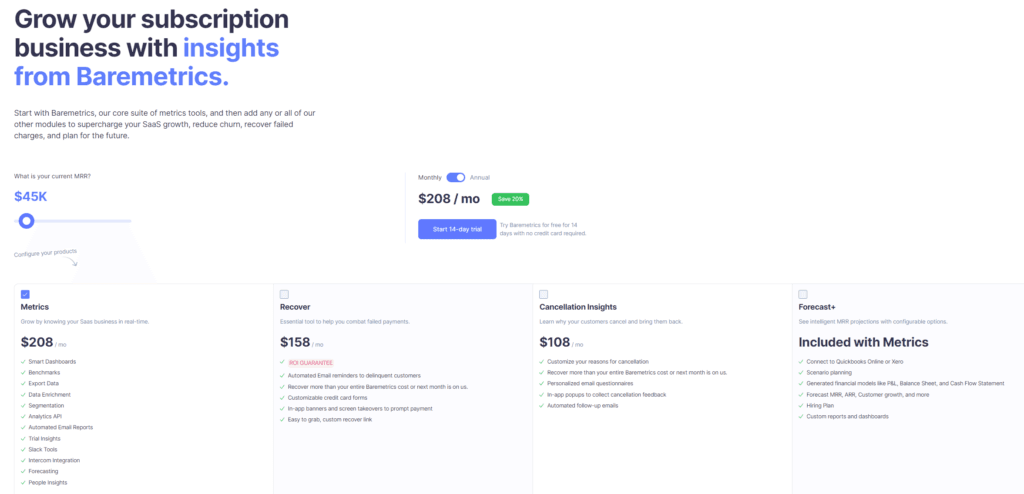Embarking on the quest to find the best CRM tool for your business can feel like setting sail on the high seas — exciting, a bit daunting, and full of potential discoveries. In today’s vast ocean of CRM tools, HubSpot Marketing Analytics and Baremetrics stand out as two leading lights, guiding businesses toward growth and success. But the question remains: which beacon should you steer towards? Let’s chart the course with a close look at one crucial aspect to kick things off: Data Insights and Analytics.
| HubSpot Marketing Analytics | Baremetrics |
|---|---|
 |  |
| G2 Score -4.4 out of 5 | G2 Score -4.6 out of 5 |
| TrustRadius Score -8.5 out of 10 | TrustRadius Score -10.0 out of 10 |
Navigating the Seas of Data Insights and Analytics
In the world of CRM and business growth, data isn’t just numbers; it’s the compass that guides your decisions. How HubSpot Marketing Analytics and Baremetrics handle this crucial element could very well determine your journey’s success.
HubSpot Marketing Analytics: The All-Seeing Lighthouse
Imagine a lighthouse standing tall, its beam cutting through the fog — that’s HubSpot Marketing Analytics in the realm of data insights. HubSpot doesn’t just collect data; it illuminates patterns, trends, and insights that can easily go unnoticed. With its comprehensive dashboard, you’re not just seeing data; you’re getting a story that tells you where your marketing efforts are shining and where they might be getting lost at sea.
HubSpot’s strength lies in its ability to track customer interactions across a multitude of channels, from first click to final sale. This integrated approach ensures you’re not looking at data in silos but as a cohesive narrative. Whether it’s the journey of a single lead or the performance of an entire campaign, HubSpot offers detailed analytics that are both deep and accessible. The platform is designed for marketers at all skill levels, turning the complex sea of data into actionable insights with intuitive tools and customizable reports.
Baremetrics: The Captain’s Trusted Compass
Baremetrics, on the other hand, is like the seasoned captain’s compass, offering precise and focused insights particularly suited for subscription-based businesses. It excels in providing real-time metrics on revenue, churn, and customer engagement, making it an invaluable tool for SaaS companies and anyone with a subscription model at their core. Baremetrics shines by offering clarity on the financial health of your business, with features like cohort analysis, LTV calculations, and churn forecasting that help you navigate the tricky waters of subscription management.
What sets Baremetrics apart is its commitment to simplicity and clarity. The platform is designed to bring the most critical metrics to the forefront, ensuring you can quickly understand your business’s financial trajectory and make informed decisions. With its straightforward interface and focused analytics, Baremetrics caters to business owners and managers who need to keep their finger on the pulse of their company’s financial and customer metrics without getting bogged down in overly complex data analysis.
Sailing Through the Waters of Pricing Models and Flexibility
Every captain knows the importance of managing the ship’s resources, and in the business world, this translates to understanding the cost implications of the tools you choose to navigate the market. Let’s delve into how HubSpot Marketing Analytics and Baremetrics structure their pricing and what this means for businesses charting their growth course.
HubSpot Marketing Analytics: The Versatile Fleet

HubSpot’s pricing model is akin to a fleet of ships, each designed for different voyages. From a free tier that offers basic functionality for small crews just setting sail, to more advanced vessels equipped for larger enterprises with complex needs, HubSpot provides a range of options. The platform’s pricing tiers – Starter, Professional, and Enterprise – are structured to grow with your business, ensuring that you have access to more sophisticated tools and greater capacity as your journey progresses.
One of the standout features of HubSpot’s pricing strategy is its transparency and the ability to customize your package with various ‘add-ons’, allowing you to tailor the platform to your specific needs without paying for unnecessary features. This flexibility makes HubSpot an attractive option for businesses of all sizes, from solo entrepreneurs to large corporations.
The value offered by HubSpot extends beyond just the features within each pricing tier; it’s also about the ecosystem of support, extensive knowledge base, and the community that users gain access to. This holistic approach ensures that businesses not only have the tools they need but also the guidance to use them effectively.
Baremetrics: Navigating Subscription Seas with Precision

Baremetrics, with its clear focus on subscription businesses, presents a pricing model that reflects its specialization. Unlike HubSpot, Baremetrics offers straightforward plans that are based on your business’s monthly recurring revenue (MRR). This approach ensures that the platform’s pricing aligns directly with the health and scale of your business – as your subscriptions grow, Baremetrics grows with you.
This pricing model is particularly appealing for SaaS companies and other subscription-based businesses, as it mirrors the challenges and milestones such companies face. The direct correlation between what you pay and your MRR highlights Baremetrics’ commitment to providing value that scales with your success.
Moreover, Baremetrics prides itself on offering features that are specifically designed to enhance the financial health of subscription models, such as churn analysis, revenue forecasting, and user segmentation. This focused toolset, combined with a pricing model that aligns with subscription business metrics, makes Baremetrics a compelling option for companies deeply embedded in the subscription economy.
Integration Capabilities: The Ties That Bind
In the digital age, businesses use a myriad of tools to capture leads, communicate with customers, manage projects, and more. The capability of your CRM platform to integrate with these tools can streamline operations, reduce manual data entry, and provide more comprehensive insights into your business processes. Let’s compare how HubSpot Marketing Analytics and Baremetrics stack up in this critical area.
HubSpot Marketing Analytics: The Central Nexus
HubSpot serves as a sprawling metropolis of integration possibilities. With a bustling marketplace of over 500 integrations, HubSpot can connect with almost any tool your business might use — from email marketing platforms like Mailchimp to social media tools like Facebook Ads, e-commerce platforms like Shopify, and even specialized tools like Salesforce for CRM or WordPress for content management.
What makes HubSpot’s integration ecosystem particularly powerful is not just the sheer volume but the depth of these integrations. They’re designed to be deeply integrated, ensuring that data flows seamlessly between HubSpot and other tools. This not only enriches the data within HubSpot but also enhances the functionality of the connected tools, creating a cohesive and powerful digital infrastructure for your business.
Baremetrics: Streamlined and Focused Connectivity
Baremetrics, with its laser focus on subscription businesses, offers a more curated list of integrations, meticulously selected to support the unique needs of SaaS and other subscription-based companies. It directly integrates with payment processors like Stripe, Braintree, and Chargebee, which are critical to its core functionality of providing real-time financial analytics.
While the list of integrations available on Baremetrics may not rival the extensive marketplace of HubSpot, each integration is tailored to deepen the platform’s analytical capabilities, offering precise insights into revenue, churn, and customer lifetime value. For businesses that operate with a subscription model, these integrations ensure that Baremetrics functions as a specialized nerve center, providing the metrics that matter most, directly and efficiently.

Related: Check out our free SEO suite

Customer Support and Educational Resources: Lifelines in the Digital Sea
The true test of a CRM tool often comes not when everything is going smoothly, but when you hit a snag. Whether it’s a technical issue, a question about a feature, or guidance on best practices, having access to timely and helpful support can make all the difference. Similarly, educational resources can empower users to fully leverage the tool’s capabilities, driving better results for their businesses.
HubSpot Marketing Analytics: A Comprehensive Support System
HubSpot shines brightly when it comes to customer support and education, offering a lighthouse of resources for businesses navigating the complexities of digital marketing. The platform provides extensive customer support through multiple channels, including 24/7 live chat, email, and phone support, ensuring that help is always within reach.
But where HubSpot truly sets itself apart is in its commitment to user education. HubSpot Academy is a treasure trove of learning, offering free online courses, certifications, and training materials on a wide array of topics, from inbound marketing and content strategy to sales and customer service. These resources are not only designed to help users maximize the use of the HubSpot platform but also to enrich their overall marketing and sales expertise.
Moreover, HubSpot’s community forum is a vibrant space for users to ask questions, share insights, and collaborate with peers. This peer-to-peer support network, combined with HubSpot’s comprehensive knowledge base, ensures that users have access to a wide spectrum of information and support.
Baremetrics: Targeted Support for Subscription Success
Baremetrics focuses its support and educational resources on the specific needs of subscription-based businesses, offering a streamlined and targeted approach. Customer support is provided through email and live chat, with a strong reputation for responsiveness and helpfulness. The Baremetrics team is known for its hands-on approach, often going above and beyond to assist users with their queries and challenges.
In terms of education, Baremetrics offers a wealth of articles, guides, and blog posts that delve into the intricacies of subscription business metrics, financial analysis, and growth strategies. While it may not offer a formal educational platform like HubSpot Academy, Baremetrics provides valuable insights and advice tailored to the unique challenges faced by SaaS and other subscription models.
The Baremetrics blog and case studies serve as practical resources, showcasing real-world applications of the platform’s analytics capabilities and offering inspiration and strategies for subscription business growth.
User Interface and User Experience: Sailing with Ease
A CRM tool can have all the features in the world, but if navigating it feels like charting through a stormy sea, its utility becomes significantly diminished. A well-designed UI and thoughtful UX can make the difference between a tool that boosts your productivity and one that slows you down.
HubSpot Marketing Analytics: The Friendly Harbor
HubSpot has long been praised for its user-friendly interface, which serves as a welcoming harbor for marketers of all skill levels. The platform is designed with clarity and ease of use in mind, making it accessible to newcomers while still offering the depth that experienced marketers need. Its dashboard presents a clear overview of your marketing efforts, with easily navigable menus and intuitive controls that make it simple to dive into more detailed analyses or manage campaigns.
The UX of HubSpot is complemented by its visual design, which is not only aesthetically pleasing but also functional, with a layout that logically organizes information and tools. This thoughtful design extends to its mobile app, ensuring that you can keep a finger on the pulse of your marketing activities, even when you’re on the move.
Moreover, HubSpot’s commitment to a positive user experience is evident in its onboarding process and continuous support, guiding users through learning the platform’s features and best practices. This approach helps reduce the learning curve and ensures businesses can quickly leverage the platform to its full potential.
Baremetrics: The Navigator’s Tool
Baremetrics, tailored for the intricacies of subscription-based businesses, offers a UI and UX that are focused on delivering clear, actionable insights with minimal fuss. The dashboard is streamlined and focused, presenting the key metrics that subscription businesses care about most, such as MRR, ARR, churn rate, and customer lifetime value, at a glance.
The platform’s interface is clean and uncluttered, emphasizing data visualization to help users quickly grasp their financial health and customer behavior. This focus on simplicity does not sacrifice depth; users can easily drill down into more detailed metrics and analyses with just a few clicks.
While Baremetrics may offer fewer bells and whistles than HubSpot, its user experience is tailored to its audience, providing a straightforward and effective tool for subscription businesses that need to monitor and analyze their metrics without unnecessary complexity.
Conclusion
As we conclude our exploration of HubSpot Marketing Analytics versus Baremetrics, it’s evident that both platforms offer distinct advantages tailored to different types of businesses and their specific needs. Through our detailed comparison across key areas — data insights and analytics, pricing models and flexibility, integration capabilities, customer support and educational resources, and the user interface and user experience — we’ve navigated the unique features and benefits that each platform brings to the table.
READ NEXT:
- Bitrix24 vs Vtiger: The Best CRM Tool for You
- MicroStrategy vs Mixpanel: The Best Analytics Tool for You
- HubSpot Marketing Analytics vs Kissmetrics: The Best Analytics Tool for You
- Company Formation: DIY vs. Hiring a Professional Service
- 11 Marketing Analytics Tools to Elevate Your Data-Driven Strategies
- 29+ Digital Analytics Software to Skyrocket Your Digital ROI
- Digital Nomads: Setting Up a Limited Company in the UK





















